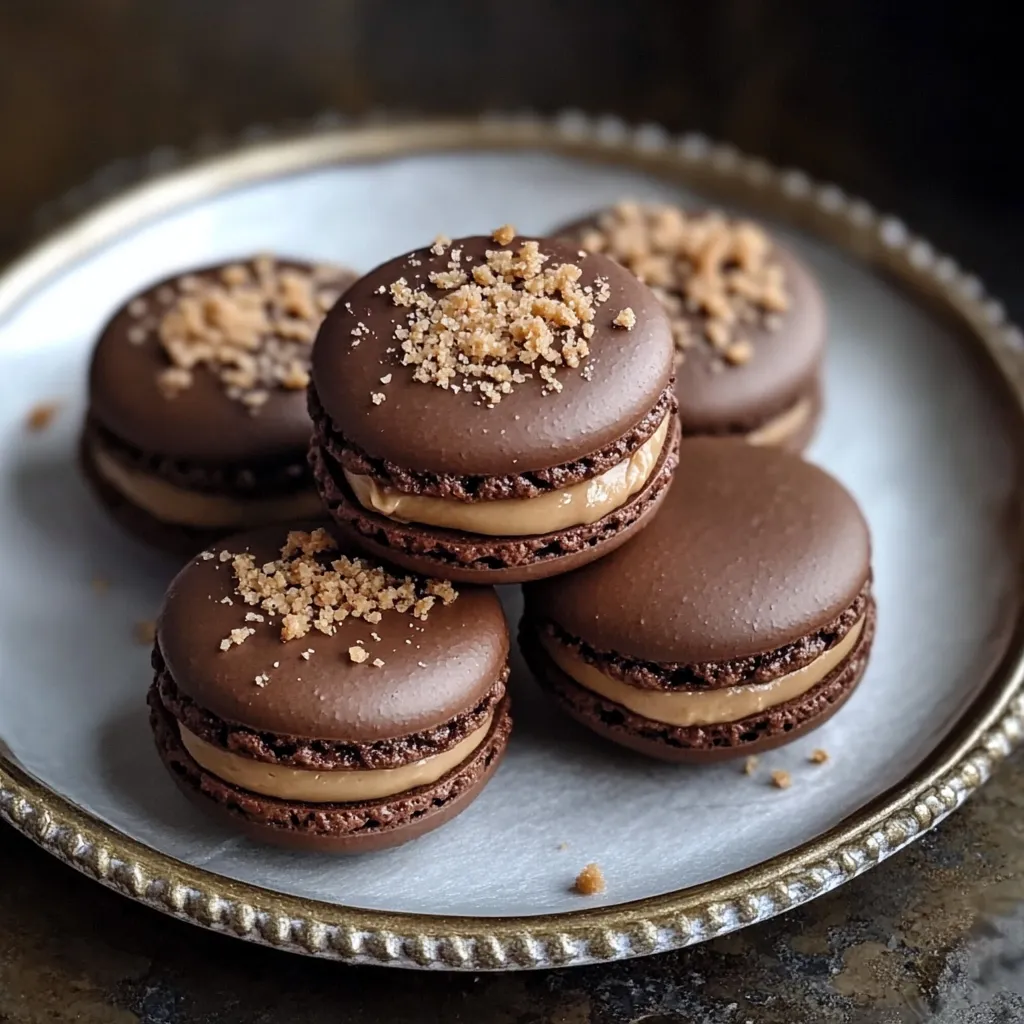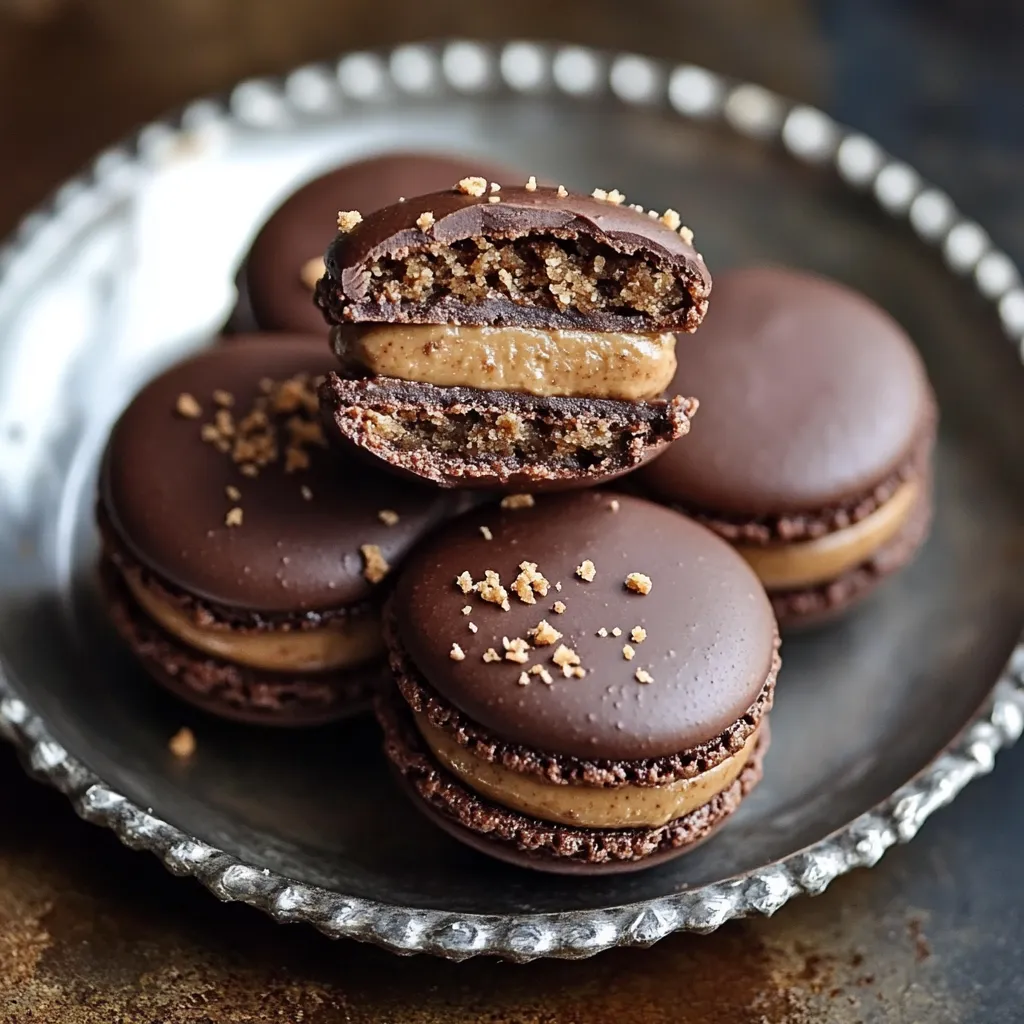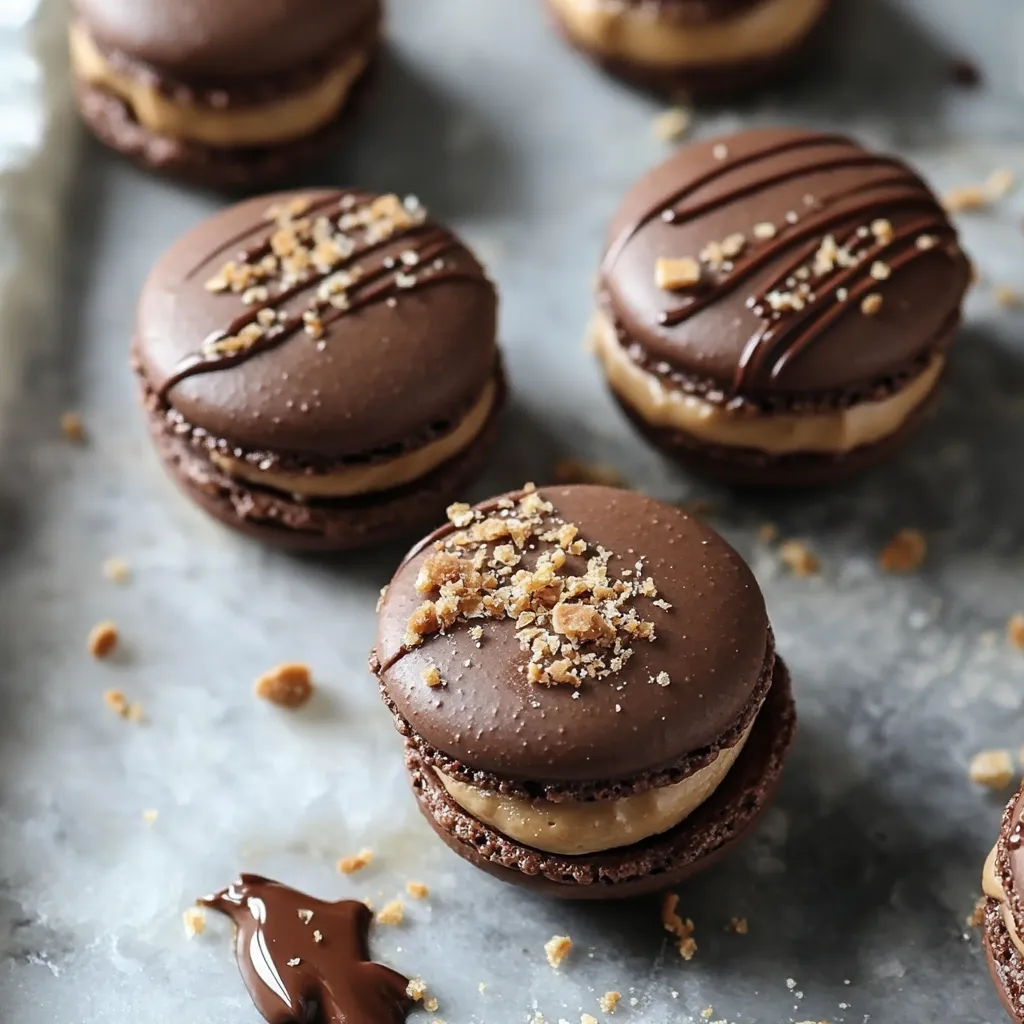 Pin it
Pin it
This chocolate peanut butter macaron recipe transforms simple ingredients into elegant French-inspired treats with a nostalgic American twist. The rich chocolate shells paired with creamy peanut butter filling creates an irresistible combination that satisfies sophisticated palates while evoking childhood comfort.
I discovered this technique after multiple macaron failures and now this is my go to method for entertaining guests who are always impressed but have no idea how straightforward these actually are to make.
Ingredients
- For the chocolate macarons:
- 100 grams egg whites: Room temperature for best volume
- 100 grams granulated sugar: Creates stability in the meringue
- 100 grams almond flour: Provides the classic macaron texture and nutty flavor
- 100 grams powdered sugar: Sweetens without affecting moisture
- 2 tablespoons unsweetened cocoa powder: Adds chocolate flavor without excess sweetness
- For the peanut butter filling:
- 1/4 cup butter: Softened for smooth blending
- 1/3 cup peanut butter: Use natural or commercial based on texture preference
- 1 cup powdered sugar: Creates pipeable consistency
- 1 teaspoon vanilla extract: Enhances the peanut butter flavor
- 1/4 teaspoon salt: Balances sweetness and amplifies flavor
Step-by-Step Instructions
- Prepare Your Workspace:
- Preheat oven to 300°F and line two baking sheets with parchment paper. Having everything ready before starting ensures smooth workflow as timing matters with macarons.
- Create Swiss Meringue:
- Heat egg whites and granulated sugar in a double boiler setup until sugar completely dissolves and mixture becomes frothy about 1 to 1.5 minutes. This step creates a stable meringue base that is more forgiving than other methods.
- Whip To Stiff Peaks:
- Transfer mixture to stand mixer and whisk on high speed for 2 to 3 minutes until stiff peaks form. The meringue should stand tall when the whisk is lifted and have a glossy appearance indicating it has reached the proper structure.
- Incorporate Dry Ingredients:
- Sift the almond flour cocoa powder and powdered sugar together before gently adding to meringue. Sifting removes lumps that would destroy the smooth texture of your macaron shells.
- Achieve Proper Macaronage:
- Mix on medium speed for short intervals testing consistency between mixes. The perfect batter should flow like slow moving lava allowing you to draw a figure eight without breaking. This critical step determines whether your macarons will have the characteristic feet when baked.
- Pipe Macaron Shells:
- Transfer batter to a pastry bag with a 1 inch tip and pipe consistent silver dollar sized circles onto prepared baking sheets. Keep 1.5 inches between each to allow for proper air circulation during baking.
- Remove Air Bubbles:
- Bang the baking sheet firmly on the counter twice to release trapped air bubbles that could cause cracking. This simple step significantly improves the final appearance of your macarons.
- Bake Immediately:
- Place in preheated oven for 13 minutes rotating halfway through for even baking. Unlike traditional methods these macarons do not require drying time saving you 30 to 60 minutes in preparation.
 Pin it
Pin it
The unsweetened cocoa powder is truly the star ingredient here. I once tried using Dutch processed cocoa and the flavor was noticeably richer with beautiful deep color. My daughter now requests these instead of birthday cake every year which speaks volumes about their crowd pleasing flavor.
The Science Behind Perfect Macarons
The Swiss meringue method used in this recipe provides more stability than the traditional French method. By heating the egg whites and sugar together first, you create a more stable structure that is less likely to deflate during the folding process. This is why these macarons are more consistent and forgiving for home bakers.
Troubleshooting Common Macaron Problems
Cracked shells usually indicate oven temperature is too high or batter was undermixed. Try reducing temperature by 10 degrees or mix batter slightly longer next time.
No feet developing suggests either overmixing or humidity issues. Be careful not to overwork the batter and try baking on a dry day if possible.
Hollow shells typically mean the meringue was overbeaten or the oven temperature fluctuated. Whip just until stiff peaks form and consider using an oven thermometer to ensure consistent temperature.
Flavor Variations
Transform this base recipe by swapping the peanut butter filling with alternative options. Nutella creates a double chocolate experience while raspberry jam offers a fruity contrast to the chocolate shells. You could also add espresso powder to the shells for a mocha version that pairs beautifully with the original peanut butter filling.
 Pin it
Pin it
With these tips, you'll master macarons and wow anyone who tries them — every batch will turn out just perfect.
Frequently Asked Questions
- → Why don't these macarons need to air dry before baking?
This recipe uses a Swiss meringue base which creates a more stable structure, eliminating the traditional need for air-drying. This saves time while still producing the classic macaron texture and feet.
- → How do I know when my macaron batter has the right consistency?
The perfect consistency resembles slow-moving lava. When you lift your spatula, the batter should flow down and form a figure-eight pattern without breaking. It should move slowly but continuously.
- → Can I substitute the peanut butter for another filling?
Yes! This chocolate shell pairs beautifully with alternative fillings like hazelnut spread, caramel, raspberry buttercream, or even mint chocolate ganache if you prefer different flavor combinations.
- → How should I store these macarons?
Store assembled macarons in an airtight container in the refrigerator for up to 5 days. For the best texture and flavor, allow them to come to room temperature for about 20 minutes before serving.
- → Why did my macarons crack during baking?
Cracking usually indicates the oven temperature was too high. Consider using an oven thermometer to verify temperature accuracy, and position the rack in the middle of the oven away from heating elements.
- → How can I ensure my macarons have perfect feet?
The distinctive 'feet' (ruffled edges) form best when the batter has the right consistency, the oven is at the proper temperature (300°F), and the baking sheets aren't overcrowded, allowing proper air circulation.
